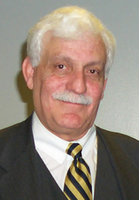










Raymond Vahan Damadian (born March 16, 1936) is an American physician, medical practitioner, and inventor of the first MR (Magnetic Resonance) Scanning Machine.His research into sodium and potassium in living cells led him to his first experiments with nuclear magnetic resonance (NMR) which caused him to first propose the MR body scanner in 1969. Damadian discovered that tumors and normal tissue can be distinguished in vivo by nuclear magnetic resonance (NMR) because of their relaxation times, both T1 (spin-lattice relaxation) or T2 (spin-spin relaxation). Damadian was the first to perform a full body scan of a human being in 1977 to diagnose cancer. Damadian invented an apparatus and method to use NMR safely and accurately to scan the human body, a method now well known as magnetic resonance imaging (MRI).
Early life & Studies
Damadian was born in New York, to an Armenian family. He earned his bachelor's degree in mathematics from the University of Wisconsin–Madison in 1956, and an M.D. degree from the Albert Einstein College of Medicine in New York City in 1960. He studied the violin at Juilliard for 8 years.
MRI(Magnetic Resonance Imaging)
Damadian's early work on NMR concerned investigating potassium ions inside cells.He found that the potassium relaxation times were much shorter compared with aqueous solutions of potassium ions. This suggested that potassium was not free but complexed to ‘fixed-charge’ counter-ions, as he had previously determined.
He and other researchers independently investigated the signals of 1H NMR in cells, and found that the relaxation times were much shorter than in distilled water. This was consistent with ordering of a large part of the water by adsorption onto macromolecular surfaces. Damadian predicted that cancerous cells would have longer relaxation times, both because of the disordering of malignant cells and because of their elevated potassium levels, since the potassium ions would be ‘structure-breaking’ to the ordered water fraction.
Damadian received a National Medal of Technology in 1988 and was inducted into the National Inventors Hall of Fame in 1989. His original MRI full-body scanner was given to the Smithsonian Institution in the 1980s and is now on loan and on display at the National Inventors Hall of Fame in Ohio.In 2001, the Lemelson-MIT Prize Program bestowed its $100,000 Lifetime Achievement Award on Damadian as "the man who invented the MRI scanner."The Franklin Institute in Philadelphia gave its recognition of Damadian's work on MRI with the Bower Award in Business Leadership. He was named the Knights of Vartan 2003 "Man of the Year." In September 2003, he was honored with the Innovation Award in Bioscience from The Economist.